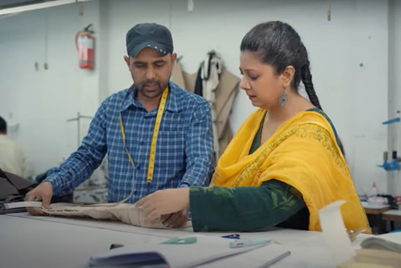
The impact of an ad campaign doesn’t always have to arise from a big idea. It could even be rooted in a real-life scenario that its story is based on.
Piramal Finance’s ‘Parakh’ (Evaluation) seeks to do exactly that. Crafted in collaboration with its creative ad agency, The Womb, the campaign features six long-format ad films in Hindi, Kannada, Marathi, Tamil, and Telugu.
Anchored by reputed regional celebrities like Brahmaji, Neelesh Misra, Nivedita Saraf, Nizhalgal Ravi, and Vinaya Prasad, these films present real-life stories of six loan customers of Piramal Finance. They belong to a group of blue-collar workers and small business owners from across India who epitomise the target customer base that the financial services company targets for its housing and commercial loan products.
According to Arvind Iyer, head of marketing at Piramal Finance, the people in this group often lack the paperwork required by conventional systems. They are usually at the fringes of organised lending. “But we believe their intent and potential deserve lending support and recognition,” he added.

Banking and financial institutions in India usually do not serve these customer classes, instead prefering to focus on salaried individuals or established corporate spenders. Hence, most of these underserved consumers, often deemed high-risk by conventional lenders, find it nearly impossible to obtain loans despite their intent and ability to repay.
This is illustrated in one of Piramal Finance's ad films, Sabra ki parakh (Test of patience). Shri Maya Dhar, a tea seller hailing from Odisha, is the protagonist who is interviewed by the anchor, Nilesh Misra. Narrating his ordeal on being rejected by banks for a loan to construct his house, Dhar recalls, ‘Un logon ka soch yehi hai, ki yeh toh chaay ka thela lagaata hain. Kaise karjaa chukayega?’ (The bank people think that way; ‘How will this tea seller be able to repay the loan?’)
This short conversation subtly, but aptly, conveys the brand's message to its target audience—that even a small tea seller struggling to build his dream home managed to get a loan from Piramal Finance, while other financial institutions shunned him.
Parakh builds on a previous campaign, which the company had launched over a year ago. Titled ‘Neeyat’ (Intent), this one too tried to humanise the process of lending to the under-financed with its brand message, ‘Hum kagaz se jyada, neeyat dekhte hain’ (We pay more attention to a borrower’s intent rather than documents). This time around, Parakh focuses on the next component of the financier’s business model: the evaluation of the borrower’s creditworthiness.
Down to the brass tacks
Piramal Finance's products target the underserved customer class. They include housing loans, MSME loans, used car loans, and loans against mutual funds. To effectively target these borrowers, the company employs its proprietary AI-powered credit evaluation system, which examines data from lakhs of cases to accurately predict customer behaviour and intent. The system evaluates various parameters, including the number of years in business, regularity of rent payments, account receivables, cash in hand, daily and weekly working capital, GST filing data, etc.
In addition to the technical assessment of these tangible data, Piramal Finance also relies on on-ground feedback from its staff members. These people observe intangible aspects such as the quality and consistency of services offered and the customer loyalty that the applicant enjoys. According to Iyer, this provides a holistic view of the applicant’s loan eligibility.
With a network of more than 508 branches and a team of 13,700 professionals, Piramal Finance claims to service over 42 lakh loan customers across 13,000 Indian PIN codes. Considering that India has more than 19,000 PIN codes, this represents nearly 67% of the country’s geography. This business footprint illustrates the company's bottom-of-the-pyramid strategy for its loan products, and explains why it emphasises on campaigns like Neeyat and Parakh.
The campaign-craft
It would, however, be a fallacy to presume that Parakh's storytelling is limited to being emotive; it is business-driven as well. The narrative of each film strikes a specific psychological chord with the target audience—all related to the pain that the target community experiences due to lack of access to capital.
The films capture the journeys of borrowers who travel through a series of emotions—of rejection, self-doubt, and dejection—followed by joy upon receiving the loan they desperately need.

Before initiating the campaign, the brand and agency teams reviewed more than 75 customer stories. The final set of six stories were selected based on the diverse geographies they needed to represent.
Navin Talreja, The Womb's founding partner explained the reason behind choosing long-format over the conventional short-duration ad-films. “We didn’t start with the idea of making long-format films. The format emerged naturally as we explored Piramal Finance’s customer stories. We realised these stories were too rich and layered for shorter formats.”
The project experience
Unlike the conventional ad films, the protagonists of the films were not actors. They were real individual customers, such as small business owners, who narrated their stories describing the financial hurdles and emotional upheavals they experienced. As a result, making these films posed a few unique challenges.
“Filming real people in their natural setting required earning their trust. Some people were initially uncomfortable in front of the camera; so we had to spend many days building a rapport with them,” Talreja added.
The involvement of anchors was another deviation from the norm of conventional host roles. “We chose credible personalities for their ability to connect emotionally with the protagonists and navigate cultural nuances,” explained Iyer.
The anchors helped ensure that the narratives stayed genuine and also resonated with the respective regional audiences. However, being new to the domain, they, too, needed to spend time to get familiarised with the domain and the film protagonists.
As the films were shot at the locations of the borrowers, the production team also had to deal with a few logistical challenges. Travelling to remote locations with crew and equipment, and dealing with unpredictable weather conditions, such as scorching heat or rains, were some of the issues the project teams faced. “One challenging moment,” recollects Talreja, “was during a street vendor’s shoot when a sudden rainstorm added an unexpected poignancy to the scene.”
However, the project also had its cathartic moments. Talreja recalled that during one of the shoots, the protagonist broke down while narrating the struggles he experienced—despite being capable of repaying a loan. The episode highlighted the importance of lending support to these individuals, who had the calibre, grit, and dreams to make it big.
“One of the most humbling aspects,” Talreja added, “was neighbours joining in spontaneously during one of the shoots, sharing how a loan had uplifted the entire community. It reaffirmed the collective impact of financial inclusion.”
Piramal Finance will examine Parakh's success using multiple metrics, including viewership, view-through rates, and customer engagement. “Our primary goal is to build trust and brand affinity. But we also aim to grow our customer base by 35-40% annually,” Iyer explained. The campaign’s ability to minimise drop-offs midway in the customer journey—from initial awareness to loan application—is also seen as another significant parameter of its success.
While currently being promoted on the brand’s YouTube channel, the company is also exploring a tie-up with an OTT services player to broadcast these films. In addition, the brand will tap regional influencers to promote the campaign films in the hinterland.
The financial entity is also exploring many other social platforms to improve engagement in regional markets. “The idea is to meet customers where they are, whether through digital channels or grassroots networks,” Iyer mentioned.
Going forward, the brand and agency teams plan to launch the next set of campaign films under the same theme, Parakh. “The plan is still in the discussion stage. The theme and the target group can be the same, but the format may be different,” informed Talreja.


.jpg&h=334&w=500&q=100&v=20250320&c=1)
.jpg&h=334&w=500&q=100&v=20250320&c=1)


.jpg&h=334&w=500&q=100&v=20250320&c=1)

.jpg&h=334&w=500&q=100&v=20250320&c=1)


.jpg&h=334&w=500&q=100&v=20250320&c=1)




.jpg&h=268&w=401&q=100&v=20250320&c=1)
.png&h=268&w=401&q=100&v=20250320&c=1)


